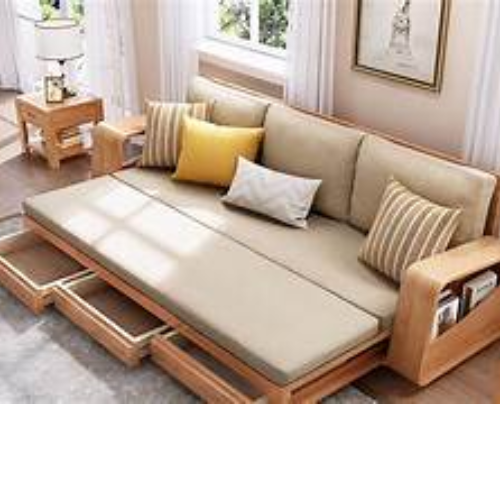Wooden sofa beds combine the versatility of a sofa and a bed with the aesthetic appeal and durability of wood. Here are the advantages and disadvantages of using a wooden sofa bed:
Advantages of Using a Wooden Sofa Bed
- Dual Functionality:
- Space-Saving: A wooden sofa bed serves as both a sofa and a bed, making it ideal for small apartments, guest rooms, or multipurpose spaces. It maximizes the use of available space, offering seating during the day and a bed at night.
- Cost-Effective: Instead of purchasing separate furniture pieces, a wooden sofa bed offers the benefits of two in one, which can be more economical in the long run.
- Durability:
- Long-Lasting Material: Wood is a highly durable material. A well-crafted wooden sofa bed can withstand daily use, lasting for many years without significant wear and tear.
- Robust Construction: The solid wood frame provides strong structural support, ensuring that the sofa bed remains sturdy both as a seating option and as a bed.
- Aesthetic Appeal:
- Timeless Design: Wooden sofa beds often feature classic, elegant designs that complement various interior styles, from traditional to contemporary.
- Natural Beauty: The natural grain and texture of wood add warmth and character to the furniture, enhancing the overall look of your living space.
- Eco-Friendly:
- Sustainability: If made from sustainably sourced wood, a wooden sofa bed is an environmentally friendly option. Wood is a renewable resource, and many manufacturers offer products that are eco-conscious.
- Biodegradability: Unlike synthetic materials, wood is biodegradable, making it a more sustainable choice for furniture.
- Versatility in Design:
- Customization: Wooden sofa beds can be customized in terms of finish, color, and style to match your home decor. The versatility in design allows them to fit seamlessly into different room aesthetics.
- Ease of Maintenance:
- Simple Cleaning: Wooden surfaces are easy to clean with a damp cloth. Unlike upholstered furniture, they don’t attract dust or require frequent deep cleaning.
- Longevity of Appearance: With proper care, a wooden sofa bed can maintain its appearance for many years, avoiding the sagging or fading that might affect fabric-covered sofa beds.
Disadvantages of Using a Wooden Sofa Bed
- Weight:
- Heavy Construction: Wooden sofa beds are typically heavier than those made from materials like metal or plastic. This can make them difficult to move, particularly if you need to rearrange your furniture or relocate the sofa bed to another room.
- Challenging Assembly: Due to their weight and solid construction, wooden sofa beds can be more challenging to assemble or disassemble, often requiring more effort and time.
- Comfort Limitations:
- Firmness: Wooden sofa beds may have a firmer feel compared to those with fully upholstered or cushioned frames. While some people appreciate the support, others might find it less comfortable, especially for sleeping.
- Cushion Dependency: The comfort of a wooden sofa bed largely depends on the quality of the cushions and mattress used. If the cushions are not plush or the mattress is too thin, the bed might not provide the desired comfort for sleeping.
- Cost:
- Higher Price Point: Wooden sofa beds, especially those made from high-quality hardwoods like oak, teak, or walnut, tend to be more expensive than those made from other materials. The initial investment can be significant.
- Maintenance Costs: Over time, a wooden sofa bed may require refinishing or polishing to maintain its appearance, which can add to the overall cost of ownership.
- Susceptibility to Environmental Factors:
- Moisture Sensitivity: Wood is susceptible to moisture, which can cause warping, swelling, or cracking over time. This makes wooden sofa beds less suitable for humid environments unless properly treated or maintained.
- Temperature Fluctuations: Extreme temperature changes can cause wood to expand and contract, potentially leading to structural issues like cracks or splits.
- Maintenance Requirements:
- Periodic Care: Wooden furniture requires periodic maintenance, such as polishing, varnishing, or oiling, to keep the wood in good condition and protect it from damage.
- Prone to Scratches: Wood, while durable, can be prone to scratches and dents, especially if not properly cared for. This can affect the sofa bed’s appearance over time.
- Limited Flexibility:
- Fixed Structure: Unlike modular furniture, wooden sofa beds usually have a fixed design, offering less flexibility in terms of rearrangement or reconfiguration. This can be a limitation if you like to frequently change your living room layout.
Conclusion
Wooden sofa beds offer a blend of functionality, durability, and aesthetic appeal, making them a great choice for those who value both style and practicality. However, their weight, cost, and maintenance requirements are important factors to consider. Depending on your needs and living conditions, a wooden sofa bed could be a perfect fit or might require careful thought before purchasing.

